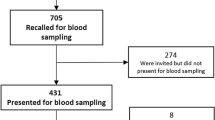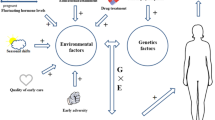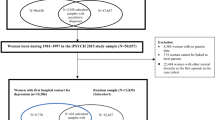Abstract
Postpartum depression (PPD) is an often underdiagnosed and undertreated mood disorder, with negative impact on the mother’s and infant’s health. Seasonal variation has been discussed as a risk factor for PPD. Candidate genes, such as those encoding for the brain-derived neurotrophic factor (BDNF), serotonin transporter (5-HTT), and Period2 (PER2), have been associated with depression and seasonal disorders. The present study is aimed to examine whether functional polymorphic variants, BDNF Val66Met, 5-HTTLPR, or PER2 SNP 10870, are associated with PPD symptoms and whether these genetic polymorphisms interact with season in predicting PPD symptoms. This case–control study comprised of 275 women from a population-based cohort of delivering women in Sweden, who completed a questionnaire containing the Edinburgh postnatal depression scale (EPDS) at 6 weeks and 6 months postpartum. Stressful life events (SLEs) and maternity stressors were also assessed. The results did not reveal any statistically significant overall association between the studied genetic polymorphisms and PPD symptoms. However, a significant association between BDNF Met66 carrier status and development of PPD symptoms at 6 weeks postpartum, even when controlling for prepartum and postpartum environmental risk factors, was evident among mothers delivering during autumn/winter. No gene–gene interactions were found but a cumulative effect was detected with carriers of a greater number of 5-HTTLPR S and BDNFVal66Met Met alleles reporting higher EPDS scores, if delivered during autumn/winter. Our findings propose a role of the BDNF gene in the development of PPD symptoms, potentially mediated by season of delivery.


Similar content being viewed by others
References
Aydemir C, Yalcin ES, Aksaray S, Kisa C, Yildirim SG, Uzbay T, Goka E (2006) Brain-derived neurotrophic factor (BDNF) changes in the serum of depressed women. Prog Neuropsychopharmacol Biol Psychiatry 30:1256–1260
Baba K, Ono D, Honma S, Honma K (2008) A TTX-sensitive local circuit is involved in the expression of PK2 and BDNF circadian rhythms in the mouse suprachiasmatic nucleus. Eur J Neurosci 27:909–916
Bailara KM, Henry C, Lestage J, Launay JM, Parrot F, Swendsen J, Sutter AL, Roux D, Dallay D, Demotes-Mainard J (2006) Decreased brain tryptophan availability as a partial determinant of post-partum blues. Psychoneuroendocrinology 31:407–413
Beck CT (1996) A meta-analysis of predictors of postpartum depression. Nurs Res 45:297–303
Beck CT (2002) Revision of the postpartum depression predictors inventory. J Obstet Gynecol Neonatal Nurs 31:394–402
Begliuomini S, Casarosa E, Pluchino N, Lenzi E, Centofanti M, Freschi L, Pieri M, Genazzani AD, Luisi S, Genazzani AR (2007) Influence of endogenous and exogenous sex hormones on plasma brain-derived neurotrophic factor. Hum Reprod 22:995–1002
Brunoni AR, Lopes M, Fregni F (2008) A systematic review and meta-analysis of clinical studies on major depression and BDNF levels: implications for the role of neuroplasticity in depression. Int J Neuropsychopharmacol 11:1169–1180
Canli T, Lesch KP (2007) Long story short: the serotonin transporter in emotion regulation and social cognition. Nat Neurosci 10:1103–1109
Carver CS, Johnson SL, Joormann J, Lemoult J, Cuccaro ML (2011) Childhood adversity interacts separately with 5-HTTLPR and BDNF to predict lifetime depression diagnosis. J Affect Disord 132:89–93
Chen ZY, Patel PD, Sant G, Meng CX, Teng KK, Hempstead BL, Lee FS (2004) Variant brain-derived neurotrophic factor (BDNF) (Met66) alters the intracellular trafficking and activity-dependent secretion of wild-type BDNF in neurosecretory cells and cortical neurons. J Neurosci 24:4401–4411
Clasen PC, Wells TT, Knopik VS, McGeary JE, Beevers CG (2011) 5-HTTLPR and BDNF Val66Met polymorphisms moderate effects of stress on rumination. Genes Brain Behav
Comasco E, Sylven SM, Papadopoulos FC, Oreland L, Sundstrom-Poromaa I, Skalkidou A (2010) Post-partum depression: a case-control study on monoaminergic functional polymorphisms and environmental stressors. Psychiatr Genet 21:19–28
Corwin EJ, Pajer K (2008) The psychoneuroimmunology of postpartum depression. J Womens Health (Larchmt) 17:1529–1534
Cox JL, Holden JM, Sagovsky R (1987) Detection of postnatal depression. Development of the 10-item Edinburgh postnatal depression scale. Br J Psychiatry 150:782–786
Deltheil T, Guiard BP, Guilloux JP, Nicolas L, Delomenie C, Reperant C, Le Maitre E, Leroux-Nicollet I, Benmansour S, Coudore F, David DJ, Gardier AM (2008) Consequences of changes in BDNF levels on serotonin neurotransmission, 5-HT transporter expression and function: studies in adult mice hippocampus. Pharmacol Biochem Behav 90:174–183
Dennis CL, McQueen K (2009) The relationship between infant-feeding outcomes and postpartum depression: a qualitative systematic review. Pediatrics 123:e736–e751
Doornbos B, Dijck-Brouwer DA, Kema IP, Tanke MA, van Goor SA, Muskiet FA, Korf J (2009) The development of peripartum depressive symptoms is associated with gene polymorphisms of MAOA, 5-HTT and COMT. Prog Neuropsychopharmacol Biol Psychiatry 33:1250–1254
DSM-IV-R (2000) Diagnostic and statistical manual of mental disorders, 4th edn, text revision. American Psychiatric Association
Duman RS, Monteggia LM (2006) A neurotrophic model for stress-related mood disorders. Biol Psychiatry 59:1116–1127
Egan MF, Kojima M, Callicott JH, Goldberg TE, Kolachana BS, Bertolino A, Zaitsev E, Gold B, Goldman D, Dean M, Lu B, Weinberger DR (2003) The BDNF Val66Met polymorphism affects activity-dependent secretion of BDNF and human memory and hippocampal function. Cell 112:257–269
Figueira P, Malloy-Diniz L, Campos SB, Miranda DM, Romano-Silva MA, De Marco L, Neves FS, Correa H (2010) An association study between the Val66Met polymorphism of the BDNF gene and postpartum depression. Arch Womens Ment Health 13:285–289
Franklin TB, Perrot-Sinal TS (2006) Sex and ovarian steroids modulate brain-derived neurotrophic factor (BDNF) protein levels in rat hippocampus under stressful and non-stressful conditions. Psychoneuroendocrinology 31:38–48
Gatt JM, Nemeroff CB, Dobson-Stone C, Paul RH, Bryant RA, Schofield PR, Gordon E, Kemp AH, Williams LM (2009) Interactions between BDNF Val66Met polymorphism and early life stress predict brain and arousal pathways to syndromal depression and anxiety. Mol Psychiatry 14:681–695
Gavin NI, Gaynes BN, Lohr KN, Meltzer-Brody S, Gartlehner G, Swinson T (2005) Perinatal depression: a systematic review of prevalence and incidence. Obstet Gynecol 106:1071–1083
Grace SL, Evindar A, Stewart DE (2003) The effect of postpartum depression on child cognitive development and behavior: a review and critical analysis of the literature. Arch Womens Ment Health 6:263–274
Hampp G, Albrecht U (2008) The circadian clock and mood-related behavior. Commun Integr Biol 1:1–3
Hampp G, Ripperger JA, Houben T, Schmutz I, Blex C, Perreau-Lenz S, Brunk I, Spanagel R, Ahnert-Hilger G, Meijer JH, Albrecht U (2008) Regulation of monoamine oxidase A by circadian-clock components implies clock influence on mood. Curr Biol 18:678–683
Heils A, Teufel A, Petri S, Stober G, Riederer P, Bengel D, Lesch KP (1996) Allelic variation of human serotonin transporter gene expression. J Neurochem 66:2621–2624
Henningsson S, Borg J, Lundberg J, Bah J, Lindstrom M, Ryding E, Jovanovic H, Saijo T, Inoue M, Rosen I, Traskman-Bendz L, Farde L, Eriksson E (2009) Genetic variation in brain-derived neurotrophic factor is associated with serotonin transporter but not serotonin-1A receptor availability in men. Biol Psychiatry 66:477–485
Hiltunen P, Jokelainen J, Ebeling H, Szajnberg N, Moilanen I (2004) Seasonal variation in postnatal depression. J Affect Disord 78:111–118
Jewell JS, Dunn AL, Bondy J, Leiferman J (2009) Prevalence of self-reported postpartum depression specific to season and latitude of birth: evaluating the PRAMS data. Matern Child Health J
Kaufman J, Yang BZ, Douglas-Palumberi H, Grasso D, Lipschitz D, Houshyar S, Krystal JH, Gelernter J (2006) Brain-derived neurotrophic factor-5-HTTLPR gene interactions and environmental modifiers of depression in children. Biol Psychiatry 59:673–680
Kim JM, Stewart R, Kim SW, Yang SJ, Shin IS, Kim YH, Yoon JS (2007) Interactions between life stressors and susceptibility genes (5-HTTLPR and BDNF) on depression in Korean elders. Biol Psychiatry 62:423–428
Lam RW, Gorman CP, Michalon M, Steiner M, Levitt AJ, Corral MR, Watson GD, Morehouse RL, Tam W, Joffe RT (1995) Multicenter, placebo-controlled study of fluoxetine in seasonal affective disorder. Am J Psychiatry 152:1765–1770
Lang UE, Hellweg R, Gallinat J (2004) BDNF serum concentrations in healthy volunteers are associated with depression-related personality traits. Neuropsychopharmacology 29:795–798
Lavebratt C, Sjoholm LK, Partonen T, Schalling M, Forsell Y (2009) PER2 variantion is associated with depression vulnerability. Am J Med Genet B Neuropsychiatr Genet
Lesch KP, Gutknecht L (2005) Pharmacogenetics of the serotonin transporter. Prog Neuropsychopharmacol Biol Psychiatry 29:1062–1073
Lewy AJ, Wehr TA, Goodwin FK, Newsome DA, Markey SP (1980) Light suppresses melatonin secretion in humans. Science 210:1267–1269
Lewy AJ, Sack RL, Miller LS, Hoban TM (1987) Antidepressant and circadian phase-shifting effects of light. Science 235:352–354
Liang FQ, Allen G, Earnest D (2000) Role of brain-derived neurotrophic factor in the circadian regulation of the suprachiasmatic pacemaker by light. J Neurosci 20:2978–2987
Logsdon MC, Wisner KL, Pinto-Foltz MD (2006) The impact of postpartum depression on mothering. J Obstet Gynecol Neonatal Nurs 35:652–658
Lommatzsch M, Zingler D, Schuhbaeck K, Schloetcke K, Zingler C, Schuff-Werner P, Virchow JC (2005) The impact of age, weight and gender on BDNF levels in human platelets and plasma. Neurobiol Aging 26:115–123
Lommatzsch M, Hornych K, Zingler C, Schuff-Werner P, Hoppner J, Virchow JC (2006) Maternal serum concentrations of BDNF and depression in the perinatal period. Psychoneuroendocrinology 31:88–94
Lundh W, Gyllang C (1993) Use of the Edinburgh postnatal depression scale in some Swedish child health care centres. Scand J Caring Sci 7:149–154
Martinowich K, Lu B (2008) Interaction between BDNF and serotonin: role in mood disorders. Neuropsychopharmacology 33:73–83
Mitoma M, Yoshimura R, Sugita A, Umene W, Hori H, Nakano H, Ueda N, Nakamura J (2008) Stress at work alters serum brain-derived neurotrophic factor (BDNF) levels and plasma 3-methoxy-4-hydroxyphenylglycol (MHPG) levels in healthy volunteers: BDNF and MHPG as possible biological markers of mental stress? Prog Neuropsychopharmacol Biol Psychiatry 32:679–685
Monteleone P, Maj M (2008) The circadian basis of mood disorders: recent developments and treatment implications. Eur Neuropsychopharmacol 18:701–711
Mou X, Peterson CB, Prosser RA (2009) Tissue-type plasminogen activator-plasmin-BDNF modulate glutamate-induced phase-shifts of the mouse suprachiasmatic circadian clock in vitro. Eur J Neurosci 30:1451–1460
Nakamura TJ, Moriya T, Inoue S, Shimazoe T, Watanabe S, Ebihara S, Shinohara K (2005) Estrogen differentially regulates expression of Per1 and Per2 genes between central and peripheral clocks and between reproductive and nonreproductive tissues in female rats. J Neurosci Res 82:622–630
Oates M (2003) Perinatal psychiatric disorders: a leading cause of maternal morbidity and mortality. Br Med Bull 67:219–229
Panthangi V, West P, Savoy-Moore RT, Geeta M, Reickert E (2009) Is seasonal variation another risk factor for postpartum depression? J Am Board Fam Med 22:492–497
Partonen T, Treutlein J, Alpman A, Frank J, Johansson C, Depner M, Aron L, Rietschel M, Wellek S, Soronen P, Paunio T, Koch A, Chen P, Lathrop M, Adolfsson R, Persson ML, Kasper S, Schalling M, Peltonen L, Schumann G (2007) Three circadian clock genes Per2, Arntl, and Npas2 contribute to winter depression. Ann Med 39:229–238
Payne JL (2003) The role of estrogen in mood disorders in women. Int Rev Psychiatry 15:280–290
Pezawas L, Verchinski BA, Mattay VS, Callicott JH, Kolachana BS, Straub RE, Egan MF, Meyer-Lindenberg A, Weinberger DR (2004) The brain-derived neurotrophic factor Val66Met polymorphism and variation in human cortical morphology. J Neurosci 24:10099–10102
Pezawas L, Meyer-Lindenberg A, Goldman AL, Verchinski BA, Chen G, Kolachana BS, Egan MF, Mattay VS, Hariri AR, Weinberger DR (2008) Evidence of biologic epistasis between BDNF and SLC6A4 and implications for depression. Mol Psychiatry 13:709–716
Pluchino N, Cubeddu A, Begliuomini S, Merlini S, Giannini A, Bucci F, Casarosa E, Luisi M, Cela V, Genazzani AR (2009) Daily variation of brain-derived neurotrophic factor and cortisol in women with normal menstrual cycles, undergoing oral contraception and in postmenopause. Hum Reprod 24:2303–2309
Praschak-Rieder N, Willeit M, Wilson AA, Houle S, Meyer JH (2008) Seasonal variation in human brain serotonin transporter binding. Arch Gen Psychiatry 65:1072–1078
Rosengren A, Orth-Gomer K, Wedel H, Wilhelmsen L (1993) Stressful life events, social support, and mortality in men born in 1933. BMJ 307:1102–1105
Rybakowski JK, Suwalska A, Skibinska M, Dmitrzak-Weglarz M, Leszczynska-Rodziewicz A, Hauser J (2007) Response to lithium prophylaxis: interaction between serotonin transporter and BDNF genes. Am J Med Genet B Neuropsychiatr Genet 144B:820–823
Sanjuan J, Martin-Santos R, Garcia-Esteve L, Carot JM, Guillamat R, Gutierrez-Zotes A, Gornemann I, Canellas F, Baca-Garcia E, Jover M, Navines R, Valles V, Vilella E, de Diego Y, Castro JA, Ivorra JL, Gelabert E, Guitart M, Labad A, Mayoral F, Roca M, Gratacos M, Costas J, van Os J, de Frutos R (2008) Mood changes after delivery: role of the serotonin transporter gene. Br J Psychiatry 193:383–388
Schrocksnadel K, Widner B, Bergant A, Neurauter G, Schennach H, Schrocksnadel H, Fuchs D (2003) Longitudinal study of tryptophan degradation during and after pregnancy. Life Sci 72:785–793
Sen S, Duman R, Sanacora G (2008) Serum brain-derived neurotrophic factor, depression, and antidepressant medications: meta-analyses and implications. Biol Psychiatry 64:527–532
Shearman LP, Sriram S, Weaver DR, Maywood ES, Chaves I, Zheng B, Kume K, Lee CC, van der Horst GT, Hastings MH, Reppert SM (2000) Interacting molecular loops in the mammalian circadian clock. Science 288:1013–1019
Siuciak JA, Lewis DR, Wiegand SJ, Lindsay RM (1997) Antidepressant-like effect of brain-derived neurotrophic factor (BDNF). Pharmacol Biochem Behav 56:131–137
Skalkidou A, Sylven SM, Papadopoulos FC, Olovsson M, Larsson A, Sundstrom-Poromaa I (2009) Risk of postpartum depression in association with serum leptin and interleukin-6 levels at delivery: a nested case-control study within the UPPSAT cohort. Psychoneuroendocrinology 34:1329–1337
Soliman F, Glatt CE, Bath KG, Levita L, Jones RM, Pattwell SS, Jing D, Tottenham N, Amso D, Somerville LH, Voss HU, Glover G, Ballon DJ, Liston C, Teslovich T, Van Kempen T, Lee FS, Casey BJ (2010) A genetic variant BDNF polymorphism alters extinction learning in both mouse and human. Science 327:863–866
Spanagel R, Pendyala G, Abarca C, Zghoul T, Sanchis-Segura C, Magnone MC, Lascorz J, Depner M, Holzberg D, Soyka M, Schreiber S, Matsuda F, Lathrop M, Schumann G, Albrecht U (2005) The clock gene Per2 influences the glutamatergic system and modulates alcohol consumption. Nat Med 11:35–42
Spencer JL, Waters EM, Milner TA, Lee FS, McEwen BS (2010) BDNF variant Val66Met interacts with estrous cycle in the control of hippocampal function. Proc Natl Acad Sci U S A 107:4395–4400
Suda S, Segi-Nishida E, Newton SS, Duman RS (2008) A postpartum model in rat: behavioral and gene expression changes induced by ovarian steroid deprivation. Biol Psychiatry 64:311–319
Sun MK, Alkon DL (2006) Differential gender-related vulnerability to depression induction and converging antidepressant responses in rats. J Pharmacol Exp Ther 316:926–932
Sylvén SM, Papadopoulos FC, Olovsson M, Ekselius L, Sundstrom-Poromaa I, Skalkidou A (2010) Seasonality patterns in postpartum depression: a study from the UPPSAT cohort
Thorell LH, Kjellman B, Arned M, Lindwall-Sundel K, Walinder J, Wetterberg L (1999) Light treatment of seasonal affective disorder in combination with citalopram or placebo with 1-year follow-up. Int Clin Psychopharmacol 14(Suppl 2):S7–S11
Wang EJ, Kripke DF, Stein MT, Parry BL (2003) Measurement of illumination exposure in postpartum women. BMC Psychiatry 3:5
WHO (2009) Report on the World Health Organization working group on the classification of maternaldeaths and severe maternal morbidities. World Health Organization, Geneva
Wichers M, Kenis G, Jacobs N, Mengelers R, Derom C, Vlietinck R, van Os J (2008) The BDNF Val(66)Met×5-HTTLPR×child adversity interaction and depressive symptoms: an attempt at replication. Am J Med Genet B Neuropsychiatr Genet 147B:120–123
Wickberg B, Hwang CP (1996) The Edinburgh postnatal depression scale: validation on a Swedish community sample. Acta Psychiatr Scand 94:181–184
Yulug B, Ozan E, Kilic E (2010) Brain-derived neurotrophic factor polymorphism as a genetic risk for depression? A short review of the literature. J Neuropsychiatry Clin Neurosci 22(123):E5–E6
Zonana J, Gorman JM (2005) The neurobiology of postpartum depression. CNS Spectr 10(792–799):805
Acknowledgments
The authors would like to sincerely thank all the mothers who participated in this study, as well as all the employees at the Department of Obstetrics, Uppsala University Hospital, who helped with the distribution of questionnaires and blood sampling.
Author information
Authors and Affiliations
Corresponding author
Rights and permissions
About this article
Cite this article
Comasco, E., Sylvén, S.M., Papadopoulos, F.C. et al. Postpartum depressive symptoms and the BDNF Val66Met functional polymorphism: effect of season of delivery. Arch Womens Ment Health 14, 453–463 (2011). https://doi.org/10.1007/s00737-011-0239-x
Received:
Accepted:
Published:
Issue Date:
DOI: https://doi.org/10.1007/s00737-011-0239-x




